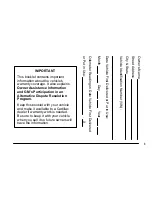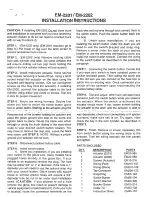
Certain driving and driving safety systems use
sensors
1
to monitor the area in front of, behind
or next to the vehicle (depending on the vehicle's
equipment).
Depending on the vehicle's equipment, the radar
sensors are integrated behind the bumpers
and/or behind the radiator grill. Keep these parts
free of dirt, ice and slush (
→
page 184). The sen‐
sors must not be covered, for example by bicycle
racks, overhanging loads or stickers. After a colli‐
sion, have the function of the radar sensors
checked at a qualified specialist workshop as
damage (both visible or non-visible) may have
occurred to the bumper or radiator trim.
Function of driving systems and driving
safety systems
In this section, you will find information about the
following driving systems and driving safety sys‐
tems:
R
ABS (Anti-lock braking system) (
→
page 137)
R
ASC (Acceleration Skid Control)
(
→
page 138)
R
BAS (Brake Assist System) (
→
page 137)
R
ESP
®
(Electronic Stability Program)
(
→
page 138)
R
EBD (Electronic Brakeforce Distribution)
(
→
page 139)
R
Active Brake Assist (
→
page 139)
R
Cruise control (
→
page 141)
R
Active Distance Assist DISTRONIC
(
→
page 142)
R
Hill start assist
R
HOLD function (
→
page 145)
R
Parking Assist PARKTRONIC
R
Rear view camera
R
360° Camera
R
ATTENTION ASSIST (
→
page 146)
R
Traffic Sign Assist (
→
page 147)
R
Blind Spot Assist (
→
page 148)
R
Active Lane Keeping Assist (
→
page 151)
Functions of ABS (Anti-lock Braking System)
Observe the important safety guidelines for the
driving safety system.
ABS controls the brake pressure in critical situa‐
tions:
R
the wheels are prevented from locking when
braking, e.g. during maximum full-stop brak‐
ing or when there is insufficient tire traction.
R
the steerability of the vehicle in terms of
physical possibilities is ensured when brak‐
ing.
R
ABS is active from speeds of approx. 3 mph
(5 km/h). On a slippery road surface, ABS
intervenes even if you only brake gently.
System limitations
If there is a malfunction and the yellow
!
ABS
warning lamp lights up continuously in the instru‐
ment display after starting the engine, ABS may
be impaired or inoperative.
If ABS intervenes, you will feel a pulsing in the
brake pedal. The pulsating brake pedal may be an
indication of hazardous road conditions and func‐
tions as a reminder to take extra care while driv‐
ing.
If ABS intervenes: keep the brake pedal firmly
depressed until the braking situation has passed.
To carry out maximum full-stop braking:
depress the brake pedal with full force.
Function of BAS (Brake Assist System)
&
WARNING Risk of an accident caused by
a malfunction in BAS (Brake Assist Sys‐
tem)
If BAS is malfunctioning, the braking distance
in an emergency braking situation is
increased.
#
Depress the brake pedal with full force
in emergency braking situations. ABS
prevents the wheels from locking.
BAS supports you with additional braking force in
an emergency braking situation.
If you depress the brake pedal quickly, BAS is
activated:
R
BAS automatically boosts the braking force of
the brakes
R
BAS can shorten the braking distance
R
ABS prevents the wheels from locking
When you release the brake pedal, the brakes
function as usual again. BAS is deactivated.
Driving and parking 137
Summary of Contents for Sprinter 2019
Page 7: ......
Page 19: ...ASpare wheel example 227 At a glance Emergencies and breakdowns 17...
Page 298: ......
















































